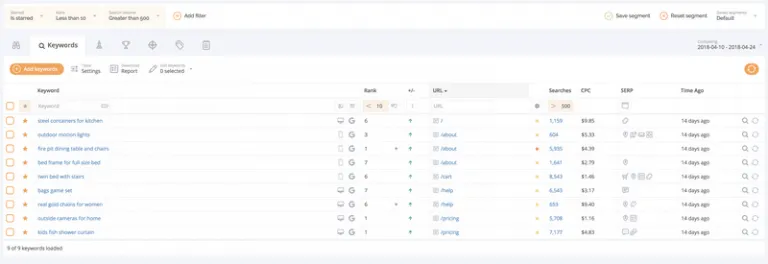
SEO Expert Shares His Experience With New Features of AccuRanker
Lukasz Zelezny
May 8, 2018
SEO Expert Shares His Experience With New Features of AccuRanker
In this interview with SEO expert Lukasz Zelezny, you will find tips and advice how to take advantage of advanced filtering and segmentation, Share of Voice as well as other new features in AccuRanker 2.0.
What are the most important factors in page optimisation in 2018?
Different SEO practitioners tend to have different opinions about the things that really matter when doing search engine optimization, particularly because the algorithms behind search engines are also changing regularly. Some may not agree with me on this, but I think there are several factors that you cannot miss in 2018.
Mobile-friendliness is at the top of that list. Google’s own Page Speed helps you figure out if your site is good enough in terms of performance and mobile-friendliness. Search engines now reward mobile-friendly sites more.
Another important factor when doing page optimization is the length of your content. While shorter contents are considered more readable, it is not a secret that longer articles – around 1000 to 2000 words – rank better. Users engage with long content better too, which brings me to the next factor: user engagement.
Time spent by visitors on your page and the bounce rate of the page are both important metrics to watch. The higher the Time on Page, the better your page will perform SEO-wise. On the contrary, you want a low bounce rate for maximum SEO performance.
One thing I also find important is errors and warnings. Eliminating these from the page greatly affects SEO performance. Thankfully, there are tools like SEMRush and DeepCrawl that make discovering and fixing errors and warnings easier.
How do you experience the new AccuRanker 2.0?
The AccuRanker 2.0 is a valuable SEO tool to use. For starters, it has a very good user experience (UX) for an SEO tool. You don’t get the sense that you’re using a technical tool, but you still get all the information you need to really understand your site’s SEO performance.
It’s really fast too, and the visualization of data done by AccuRanker is arguably the best on the market right now. You don’t have to dig deep or read through long lists of data to understand key metrics. I also love how fluid it is to use. You get that feeling of using a local machine-based software.
And then there’s the comprehensive reporting system. It’s just fantastic.
Why is the concept of Share of Voice important for understanding your SEO competition?
Simply relying on average position is not enough because this approach doesn’t paint a clear enough picture. Share of Voice or call-it Traffic Index, on the other hand, takes metrics like simplified organic CTR distribution, position, and search volume to paint the detailed picture that we need.
Additionally, in many cases, there is a strong, close to 1 correlation between real organic traffic and Share of Voice.
This is a method I’ve been using for years and one that I’m still using today. Platforms like Sistrix and Searchmetrics are also adding Share of Voice to their ecosystem (they may call this metric different).

How has advanced filtering and segmentation helped you organize your data?
It’s very important. SEO can no longer be seen as something you do for the entire site. It doesn’t work that way. Pages, products, categories, and even groups of content often require different strategies from an SEO standpoint.
The best way to understand these different parts of the site and how they perform is by collecting and analyzing granular data from the beginning. Filters and segmentation are indispensable tools that help understand the different parts of a site and how each of them needs to be treated.

How does grouping keyword data with the Tag Cloud and Landing Page functions help you measure the impact of your SEO Strategy?
Visualization is probably the biggest advantage. There is no need to pivot data or do complex processing. You can see the things you want to understand immediately, which means you can focus on fine-tuning the strategy or approach sooner than ever.
You also get a lot more information with grouping by landing page. Aside from the keyword data, you can quickly understand the changes in organic search traffic, see rankings for different keywords, and get traffic estimates all at once.


Any tips you would like to share with other AccuRanker users?
AccuRanker lets you do a lot of things without the usual complications. That’s a great start and an advantage already. The available features also allow you to push things further, and there are several things you can do indeed.
First of all, you want to prioritize keywords that rank in the top 20. Those are the keywords you need to be working with the most. AccuRanker also has this for You.
Diversify! As I mentioned earlier, SEO can no longer be seen as a blanket strategy. You can’t expect one SEO strategy to work for the entire site. Now is the perfect time to start taking different pages and fine-tuning the way they are optimized to gain better positions.
You also want to pay attention to your internal link structure. Having a clear hierarchy is, unfortunately, something that many SEO practitioners still neglect. Have a clear structure, maintain a healthy sitemap, and learn when to use rel=”nofollow” tag 🙂
Performance is another thing to work on, especially in 2018. You can use GTMetrix to measure the impact of any optimization work you do on your site. For WordPress users, try plugins like Autoptimize, WP Smush, or Hummingbird to muster the most performance from the site.
Lastly, use grouping and segmentation to your advantage. Optimize per URL or landing page rather than per keyword. You’ll be surprised by how much bigger the impact of optimization is when you start using this approach as part of your SEO efforts.
If you don’t agree or agree with me don’t forget to give me a shout via LinkedIn or my website.
Lukasz Zelezny, zelezny.uk LinkedIn
Head of SEO, Growth Hacker and Social Media Speaker Consultant working in London. Top 10 UK Marketing and Advertising Influencer.
Related blog posts

5 LLM Visibility Metrics You Should Track in 2026
SEO is now both about ranking in search engines and being visible in LLMs. We give you five visibility metrics every SEO should track in 2026.
3 December 2025Is LLM Tracking Relevant for You?
LLM tracking is not just for SEOs. It is also relevant for content teams, agencies, marketing leadership, and communication teams. Learn why here.
26 November 2025
How to Find the Best Prompts to Track for AI Visibility
Do you want to start tracking prompts to optimize your AI visibility? We give you seven practical ways to identify relevant prompts to track in LLMs.
9 November 2025
